

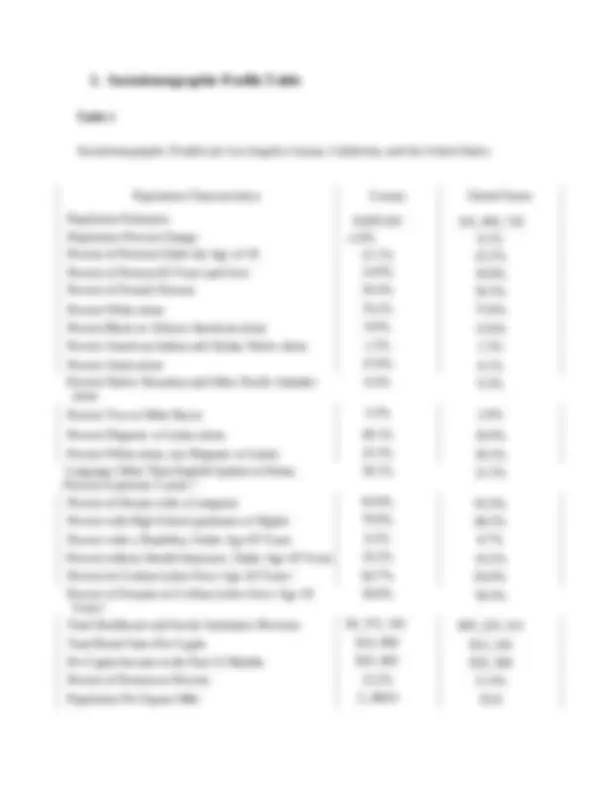
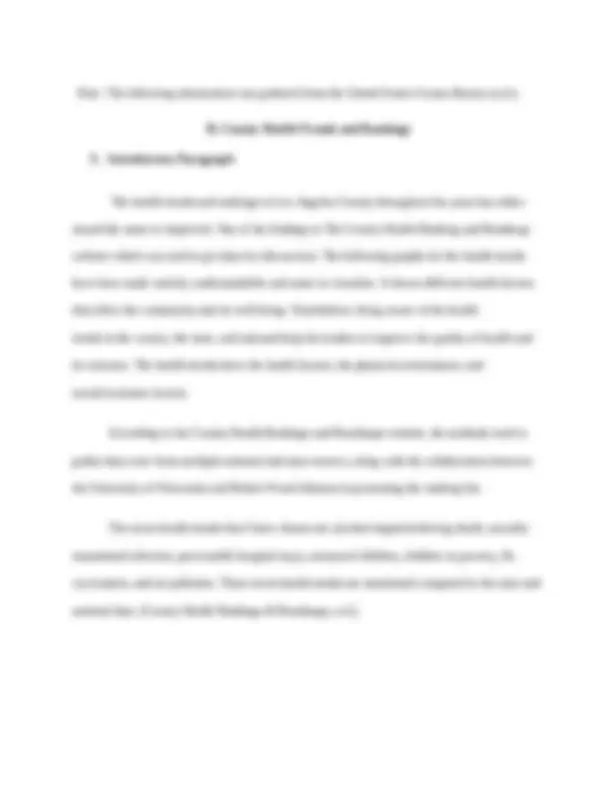
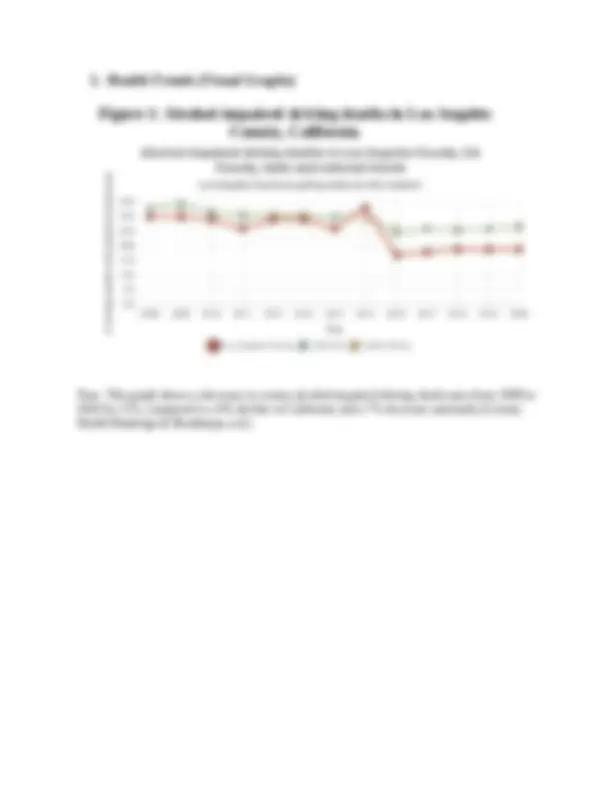
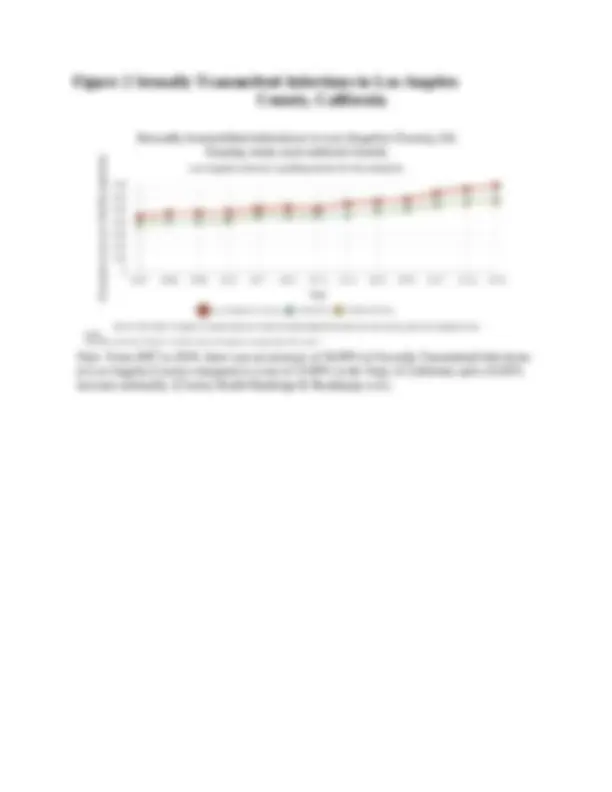
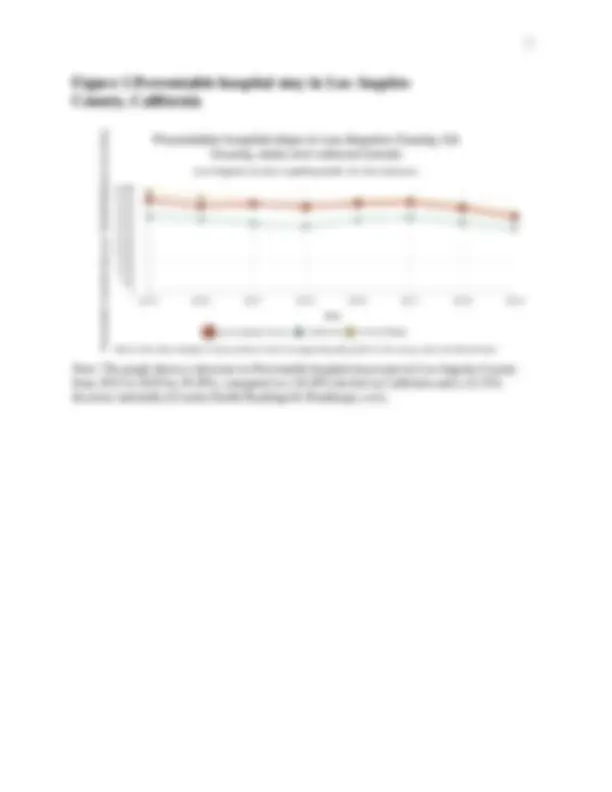
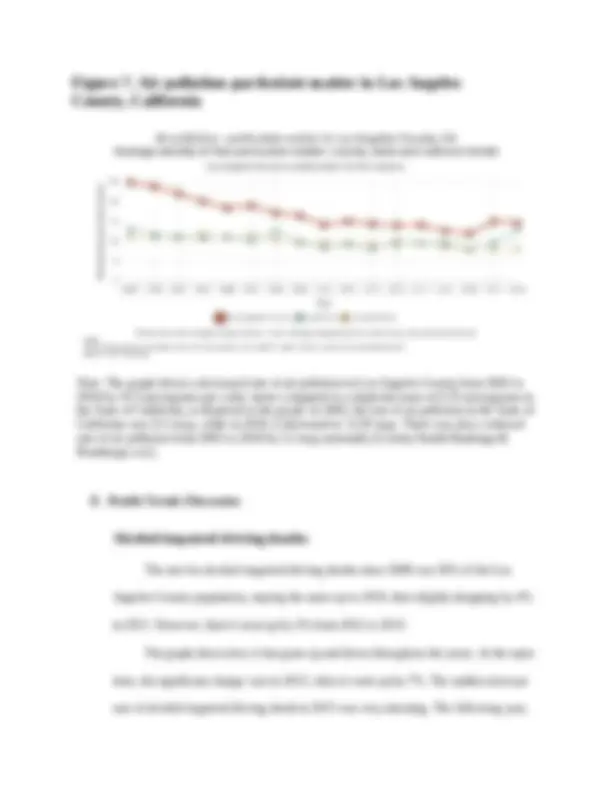
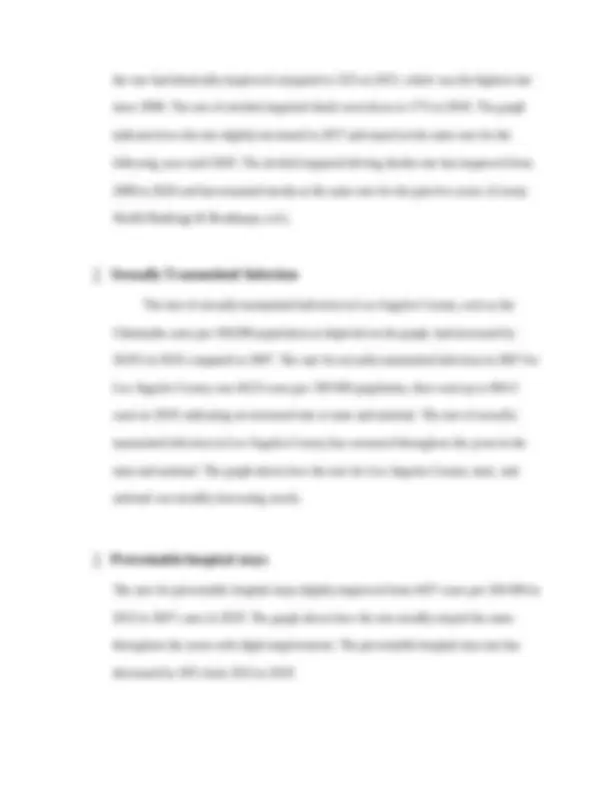
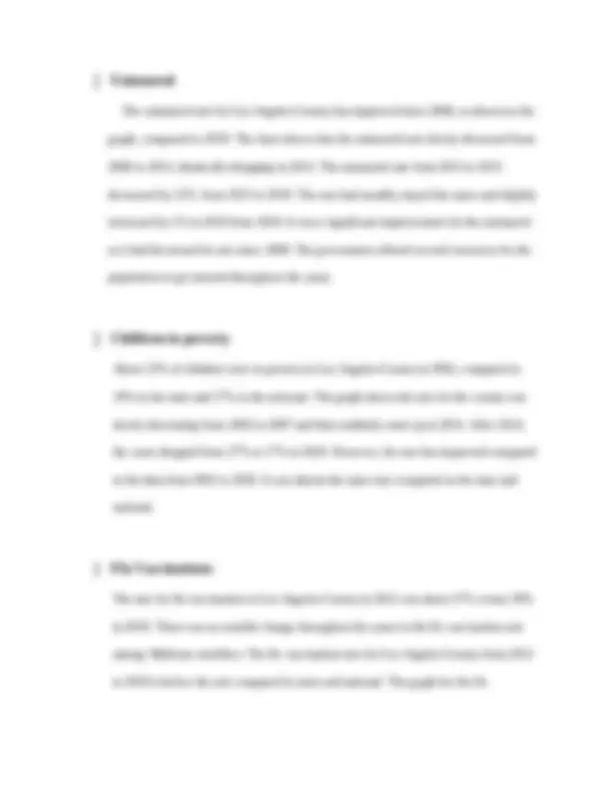

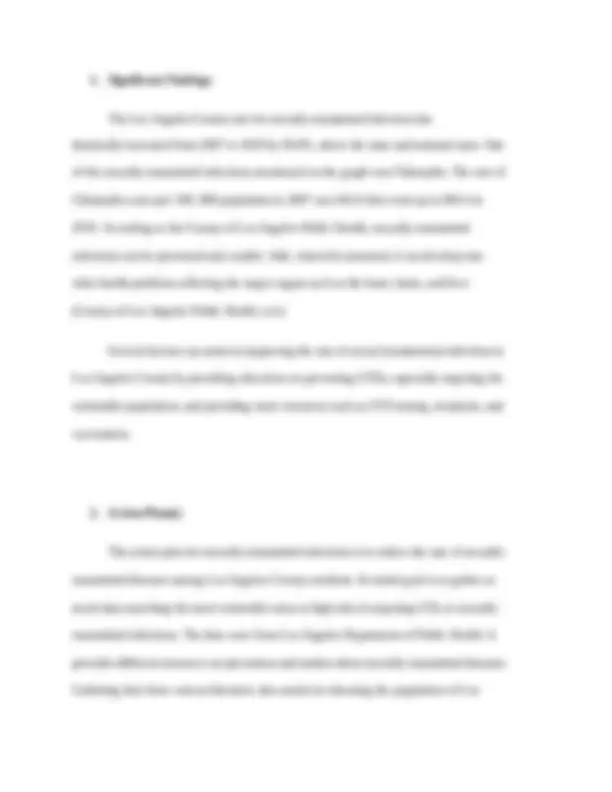
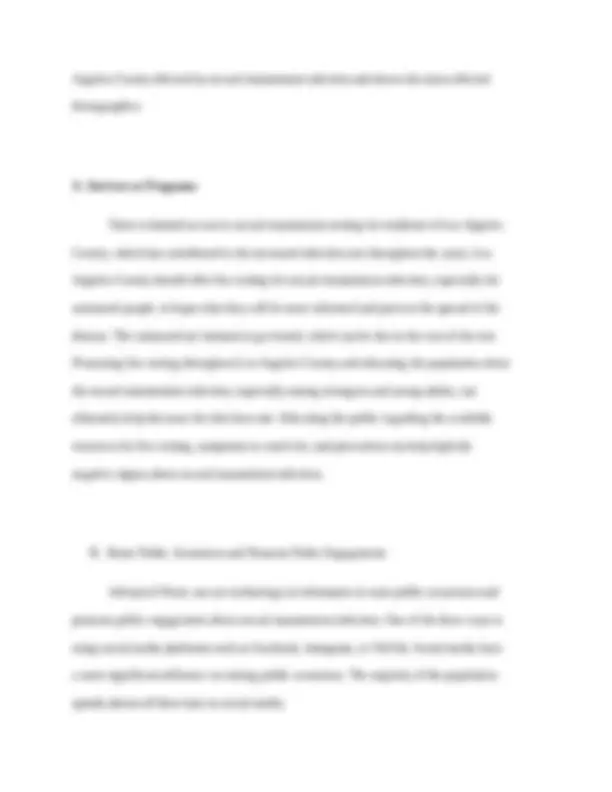
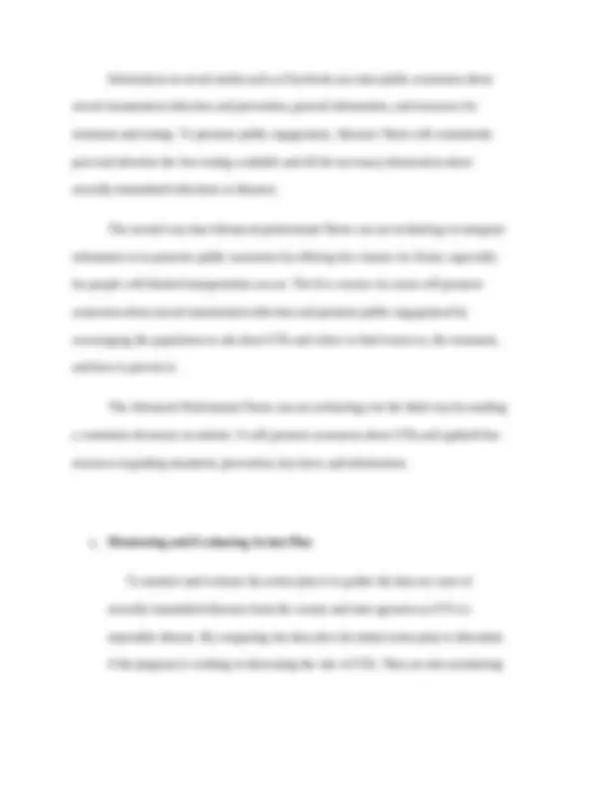




Study with the several resources on Docsity

Earn points by helping other students or get them with a premium plan


Prepare for your exams
Study with the several resources on Docsity

Earn points to download
Earn points by helping other students or get them with a premium plan
Community
Ask the community for help and clear up your study doubts
Discover the best universities in your country according to Docsity users
Free resources
Download our free guides on studying techniques, anxiety management strategies, and thesis advice from Docsity tutors
D029 Population Health Data Brief College of Health Professions, Western Governors University D029: Informatics for Transforming Nursing Care Population Health Data Brief Informatics for Transforming Nursing Care A. Sociodemographic Profile 1. Key Findings • Los Angeles County has an estimated population of 9 829 544. • The population estimate for Los Angeles County from April 1, 2020, to July 1, 2021, has decreased to 1.8%. • The unemployment rate in Los Angeles County, st
Typology: Essays (university)
1 / 23

This page cannot be seen from the preview
Don't miss anything!
















Population Health Data Brief College of Health Professions, Western Governors University D029: Informatics for Transforming Nursing Care Population Health Data Brief Informatics for Transforming Nursing Care
1. Key Findings Los Angeles County has an estimated population of 9 829 544. The population estimate for Los Angeles County from April 1, 2020, to July 1, 2021, has decreased to 1.8%. The unemployment rate in Los Angeles County, state, and national was 4% in 2019 and increased to 13% for Los Angeles County, 10% for the state, and 8% national in 2020. The uninsured rate in Los Angeles County slightly increased from 2018 to 2019 to 1%, similar to state and national. Los Angeles County population has an estimated 49.1% that are Hispanic or Latino alone, 9.5% are Black or African American alone, and 15.9% are Asian alone. Figure 1
Note. Los Angeles County, California, United States County Map (California State Association of Counties, n.d.).
The county that I chose for this project is Los Angeles County, located in Southern California, where I have lived for more than five years. The United States Census Bureau Quickfacts was used to gather the data for the Sociodemographic Profile table in this section. Los Angeles County has an estimated population of 9, 829, 544 on July 1, 2021, which decreased by 1.8% from April 1, 2020, while the nation had a slight increase of 0.1%. Los Angeles County had an estimated 2, 466.9 people per square mile in 2020, which is significantly higher than the national average. The Los Angeles County population is representative of different ethnicities. A significant portion of the population identifies as Hispanic and Latino at 49.1% (the national average is 18.9%). In addition, Los Angeles County residents identify as Black or African American at 9% and 15.6% Asian. About 56.1% of the Los Angeles County population speaks another language at home besides English, compared to 21.5% nationally (United States Census Bureau, n.d.). According to the U.S. Census Bureau website (n.d.), 14.6% of Los Angeles County residents are 65 years old and over, similar to the national population at 16.8%. Regarding education, 79.8% of the people are high school graduates or higher, slightly lower than the national average. The percentage of those living in poverty in Los Angeles County is
Table 1 Sociodemographic Profiles for Los Angeles County, California, and the United States Population Characteristics County United States Population Estimates (^) 9,829,544 (^) 331, 893, 745 Population Percent Change (^) -1.8% (^) 0.1% Percent of Persons Under the Age of 18 (^) 21.1% (^) 22.2% Percent of Persons 65 Years and Over 14.6%^ 16.8% Percent of Female Persons 50.4% (^) 50.5% Percent White alone 70.2%^ 75.8% Percent Black or African American alone 9.0%^ 13.6% Percent American Indian and Alaska Native alone 1.5%^ 1.3% Percent Asian alone 15.6%^ 6.1% Percent Native Hawaiian and Other Pacific Islander alone
Percent Two or More Races 3.3%^ 2.9% Percent Hispanic or Latino alone 49.1% (^) 18.9% Percent White alone, not Hispanic or Latino 25.3%^ 59.3% Language Other Than English Spoken at Home, Percent of persons 5 years +
Percent of Houses with a Computer 93.6%^ 91.9% Percent with High School graduates or Higher 79.8%^ 88.5% Percent with a Disability, Under Age 65 Years 6.2% (^) 8.7% Percent without Health Insurance, Under Age 65 Years 10.2%^ 10.2% Percent in Civilian Labor Force Age 16 Years+ 64.7%^ 63.0% Percent of Females in Civilian Labor Force Age 16 Years+
Total Healthcare and Social Assistance Revenue 84, 372, 181^ 895, 225, 411 Total Retail Sales Per Capita $14, 899^ $15, 244 Per Capita Income in the Past 12 Months $35, 685^ $35, 384 Percent of Persons in Poverty 13.2% (^1) 1.4% Population Per Square Mile 2, 466.9^ 93.
Note: The following information was gathered from the United States Census Bureau (n.d.). B. County Health Trends and Rankings
The health trends and rankings in Los Angeles County throughout the years has either stayed the same or improved. One of the findings is The County Health Ranking and Roadmap website which was used to get data for this section. The following graphs for the health trends have been made entirely understandable and easier to visualize. It shows different health factors that affect the community and its well-being. Nonetheless, being aware of the health trends in the county, the state, and national help the leaders to improve the quality of health and its outcome. The health trends show the health factors, the physical environment, and social/economic factors. According to the County Health Rankings and Roadmaps website, the methods used to gather data were from multiple national and state sources, along with the collaboration between the University of Wisconsin and Robert Wood Johnson in generating the ranking list. The seven health trends that I have chosen are alcohol-impaired driving death, sexually transmitted infection, preventable hospital stays, uninsured children, children in poverty, flu vaccination, and air pollution. These seven health trends are mentioned compared to the state and national data. (County Health Rankings & Roadmaps, n.d.).
in 2012 was 37%, then went up to 39%, which is below the state and national. (County Health Rankings & Roadmaps, n.d.). The trend for air pollution -particulate matter for Los Angeles County- has improved from 2002 to 2018. The rate of air pollution in Los Angeles County went down by 41% in 2020 compared to 2002, even though the rate of air pollution in the county is still above the state and national. The air quality in Los Angeles County has improved throughout the years despite the rate being above compared to the state and national. (County Health Rankings & Roadmaps, n.d.). The rank for Los Angeles County for health factors is in the lower middle range (lower 25%-50%) and higher in the middle content (50-75%) compared to the other counties in California. Los Angeles County ranks twenty-one out of 58 counties in California, while the length of life for 2022 ranks in 17 of the last year in 2021 despite the improvement rate in the preventable rate of hospital stay and the uninsured.
Figure 1 : Alcohol-impaired driving deaths in Los Angeles County, California Note : This graph shows a decrease in county alcohol-impaired driving death rates from 2008 to 2020 by 1 1%, compared to a 6% decline in California and a 7% decrease nationally (County Health Rankings & Roadmaps, n.d.).
Figure 3 Preventable hospital stay in Los Angeles County, California Note : The graph shows a decrease in Preventable hospital stays rates in Los Angeles County from 2012 to 2019 by 18.39%, compared to a 16.38% decline in California and a 22.53% decrease nationally (County Health Rankings & Roadmaps, n.d.).
Figure 4. Uninsured in Los Angeles County, California Note : The graph shows that there was a decreased rate of uninsured in Los Angeles County from 2008 to 2019, 13%, as compared to a 10% decline in the state of California and a 16% decrease nationally (County Health Rankings & Roadmaps, n.d.). Figure 5. Children in poverty in Los Angeles County, California Note : The graph shows a decreased rate of Children in poverty in Los Angeles County from 2002 to 2020 by 8% compared to a 4% decline in the State of California and a 1% decrease nationally (County Health Rankings & Roadmaps, n.d.).
Figure 7. Air pollution-particulate matter in Los Angeles County, California Note : The graph shows a decreased rate of air pollution in Los Angeles County from 2002 to 2018 by 10.3 micrograms per cubic meter compared to a slight decrease of 0.35 micrograms in the State of California, as depicted in the graph. In 2002, the rate of air pollution in the State of California was 13.2 mcg, while in 2018, it decreased to 12.85 mcg. There was also a reduced rate of air pollution from 2002 to 2018 by 3.2 mcg nationally (County Health Rankings & Roadmaps, n.d.).
The rate for alcohol-impaired driving deaths since 2008 was 30% of the Los Angeles County population, staying the same up to 2010, then slightly dropping by 4% in 201 1. However, then it went up by 3% from 2012 to 2013. The graph shows how it has gone up and down throughout the years. At the same time, the significant change was in 2015, when it went up by 7%. The sudden increase rate of alcohol-impaired driving death in 2015 was very alarming. The following year,
the rate had drastically improved compared to 32% in 2015, which was the highest rate since 2008. The rate of alcohol-impaired death went down to 17% in 2016. The graph indicates how the rate slightly increased in 2017 and stayed at the same rate for the following year until 2020. The alcohol-impaired driving deaths rate has improved from 2008 to 2020 and has remained steady at the same rate for the past few years. (County Health Rankings & Roadmaps, n.d.).
The rate of sexually transmitted infection in Los Angeles County, such as the Chlamydia cases per 100,000 population as depicted on the graph, had increased by 56.8% in 2019 compared to 2007. The rate for sexually transmitted infection in 2007 for Los Angeles County was 442.6 cases per 100 000 population, then went up to 694. cases in 2019: indicating an increased rate at state and national. The rate of sexually transmitted infection in Los Angeles County has worsened throughout the years in the state and national. The graph shows how the rate for Los Angeles County, state, and national was steadily increasing yearly.
The rate for preventable hospital stays slightly improved from 4457 cases per 100 000 in 2012 to 3637 cases in 2019. The graph shows how the rate steadily stayed the same throughout the years with slight improvement. The preventable hospital stay rate has decreased by 18% from 2012 to 2019.
vaccination rate for Los Angeles County, state, and national had relatively stayed steady throughout the years, with only a slight increase in 2019.
The graph shows that the rate of air pollution has drastically dropped from 25 mcg per cubic meter in 2002 to 14.7 mcg per cubic meter in 2018 for Los Angeles County. It shows that the rate has improved from 2002 to 2018 despite the rate for Los Angeles County being higher compared to state and national. C. Health Factors
1. Health Factors Table Table 2 Factors Influence Health Profiles for Los Angeles County and the Top U.S. Performer (County Health Rankings & Roadmaps, n.d.) Factors Influencing Health County Data State Data^ The top U.S. Performer Percent Smoking (^1) 1% 10% (^) 15% Percent with Access to Exercise Opportunities 97% 93% (^) 86% Percent Excessive Drinking 17% 19% (^) 15% Primary Care Physicians (Ratio of Population to 1 Physician)
Percent with High School Graduation (^) 80% 84% (^) 94% Percent with Some College 65%^ 74%^ 67% Percent with Unemployment
Percent of Children in Single-Parent Households 25%^ 22%^ 14% Social Associations (Number of Associations Per 5.9% 6.0 (^) 18. 10,000) Violent Crime (Number of Violent Crimes Per 100,000)
Injury Deaths (Number of Injury Deaths Per 100,000) Percent of Children Eligible for Free or Reduced- Price Lunch Air Pollution (Average Daily Density of Air Pollutants)
Percent with Severe Housing Problems 32%^ 26%^ 9%
2. Comparison of Data Several factors play a significant role in influencing health as described in the above table. It compares the county data, state data, and the top U.S. performer. The following data was collected from County Health Rankings and Roadmaps (n.d.). One of the purposes of comparing the data between the county, state, and top U.S. performers is to recognize which areas require improvement, such as the violent crime rate in Los Angeles County. The violent crime rate is above the state and top U.S. performer data. Nonetheless, the violence rate in the county was 488, compared to 63 for top U.S. performers. The unemployment rate for Los Angeles County has drastically gone up to 12.8% in 2022, showing similarities to state data. The unemployment rate for Los Angeles County can also contribute to severe housing problems, which are 32% for the county, 26% for the state, and 9% for top U.S. performers. Los Angeles County has 97% of the population with access to exercise opportunities compare to 86% for top U.S. performers and 93% for the state of California, indicating that Los Angeles County has better access to exercise opportunities.
1. Significant Findings The Los Angeles County rate for sexually transmitted infection has drastically increased from 2007 to 2019 by 56.8%, above the state and national rates. One of the sexually transmitted infections mentioned on the graph was Chlamydia. The rate of Chlamydia cases per 100, 000 population in 2007 was 442.6 then went up to 694.4 in
Angeles County affected by sexual transmission infection and shows the most affected demographics. A. Services or Programs There is limited access to sexual transmission testing for residents of Los Angeles County, which has contributed to the increased infection rate throughout the years. Los Angeles County should offer free testing for sexual transmission infection, especially for uninsured people, in hopes that they will be more informed and prevent the spread of the disease. The uninsured are hesitant to get tested, which can be due to the cost of the test. Promoting free testing throughout Los Angeles County and educating the population about the sexual transmission infection, especially among teenagers and young adults, can ultimately help decrease the infection rate. Educating the public regarding the available resources for free testing, symptoms to watch for, and prevention can help fight the negative stigma about sexual transmission infection. B. Raise Public Awareness and Promote Public Engagement Advanced Nurse can use technology in informatics to raise public awareness and promote public engagement about sexual transmission infection. One of the three ways is using social media platforms such as Facebook, Instagram, or TikTok. Social media have a more significant influence on raising public awareness. The majority of the population spends almost all their time on social media.